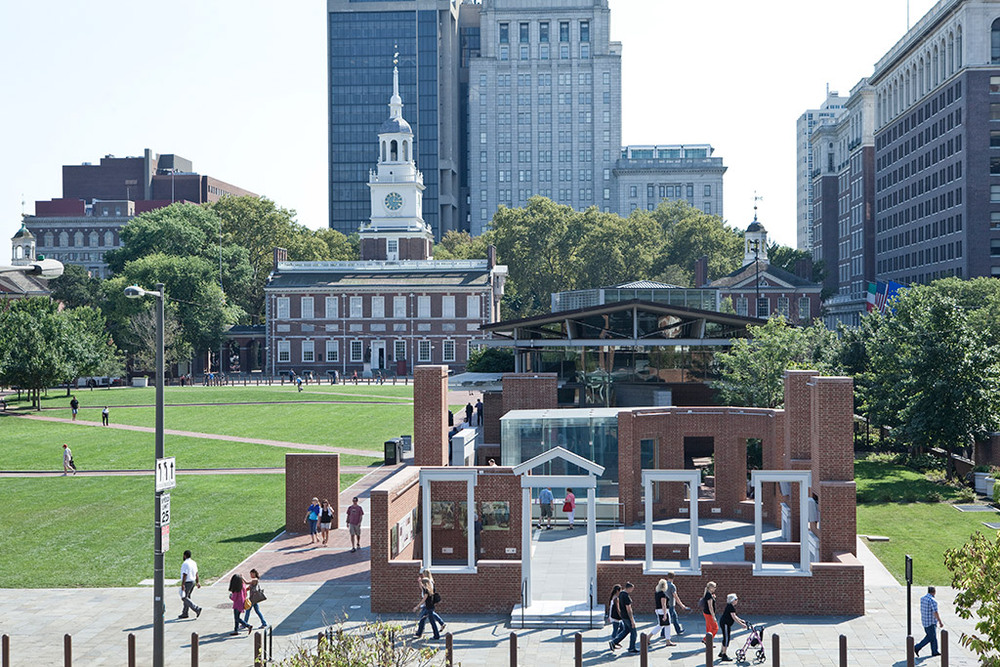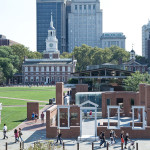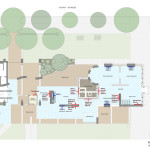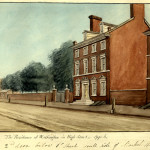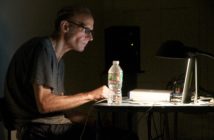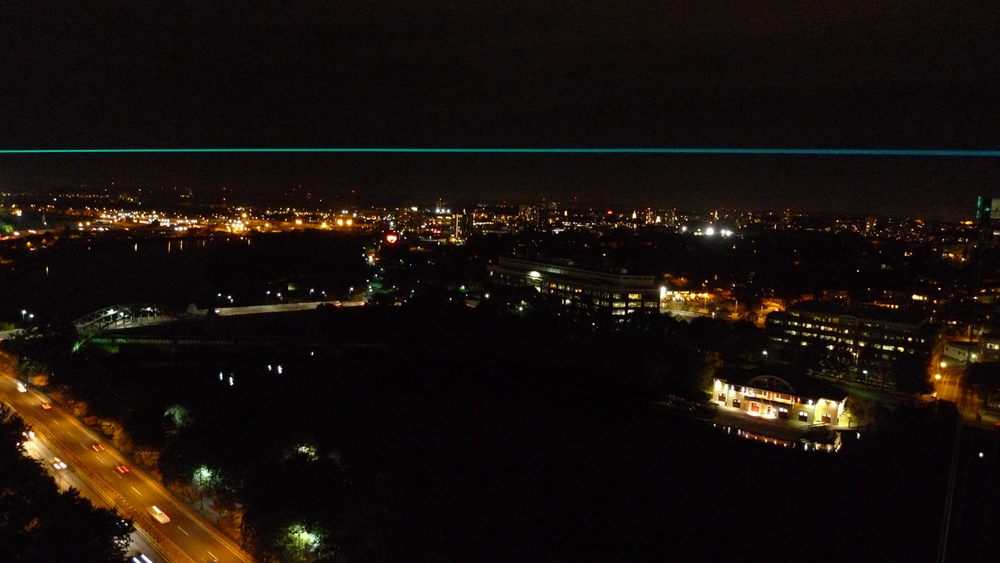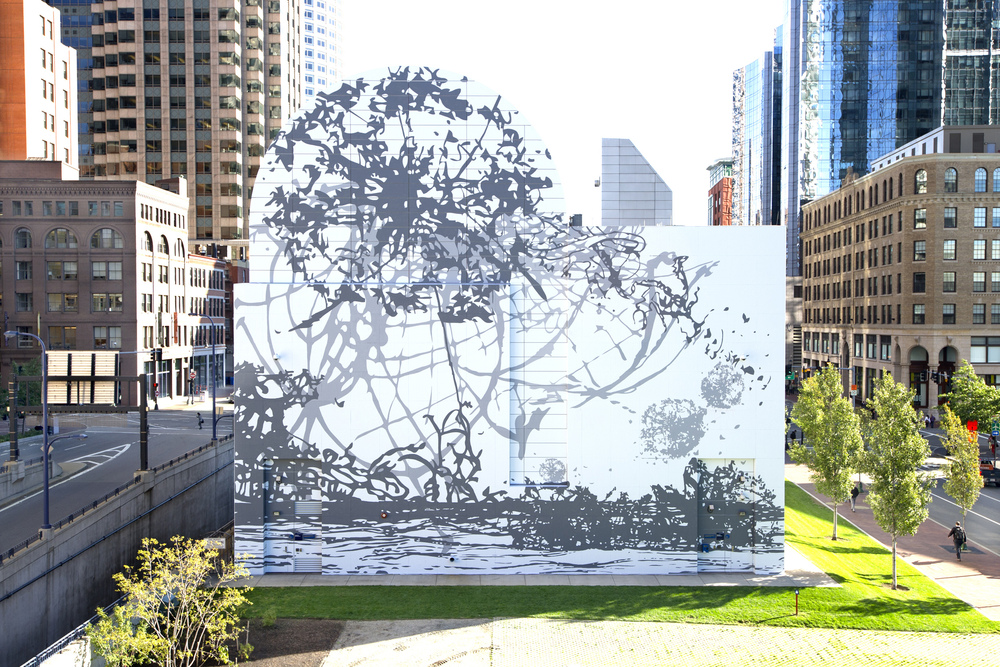At the corner of 6th and Market Streets, standing so close to the Liberty Bell Center that you can hardly pay a visit to Philadelphia’s famous metonym without bumping into it, is a newly revitalized city landmark. It now takes the form of a small open-air museum, marking the place where a house occupied by Presidents Washington and Adams once stood; its design hints at the outlines of the former mansion, though does not seek to fully replicate it.
The museum seems only half-built, standing one story high, with pillars suggesting a second floor; the windows are outlined by windowpanes, but lack glass. There is a small extant portion of the original foundation, enclosed in a glass vitrine. This partial reconstruction allows the visitor to fill in the rest with their imagination, and hints that some details of the historic site still remain disputed. The technique succeeds, for the most part, and manages to avoid devolving wholly into kitsch. Still, encountering the modern brick structure in Philadelphia’s Old City feels jarring and incongruous at a site touted for its historical significance. Yet all of Independence Mall, as it exists today—from the Independence Visitor Center to the Liberty Bell Center—is relatively new.
The official name of the site is "The President’s House: Freedom and Slavery in the Making of a New Nation," but is generally referred to by shorthand: "The President’s House." By either name, it is officially neither a museum nor a memorial, although it fuses aspects of both. Text panels line the brick walls of the structure, as they would in a history museum, and outline the history of the Executive Branch, slavery in the United States, and the archaeological process that uncovered the house’s foundation. LCD screens— designed specifically for the outdoor needs of the site— play looped videos, in which actors portraying George Washington’s slaves narrate their experience.
Yes: George Washington owned slaves and kept them here in Philadelphia, despite state laws to the contrary. To many readers of this article and visitors to the President’s House, this is not new information, but to those learning this for the first time, it is an understandably shocking and disappointing piece of history. Washington made use of a loophole in Pennsylvania’s law stating that a slave in the state for more than six months earned their freedom, and rotated his slaves to and from Mount Vernon before six months lapsed, in order to retain them as his property. He did so quietly, seeming to understand his actions would not be received well.
The small museum/memorial is not oblique or vague in addressing this history, and even seems designed to catch visitors in and out of the Liberty Bell Center, lest they view the Liberty Bell in ignorance. The official hours of the site are 8am-9pm, but it remains open later in the evening and the video remains running, and admission to the site is free. The structure has several entry points, with the main one being just off Market Street, welcoming the visitor via a set of marble stairs. One can easily cross through the House as a shortcut to the Liberty Bell, and perhaps this visitor will pause as the exhibition catches their attention. An extended visit to the museum, taking in the whole exhibition, would likely not fill an hour.
The Liberty Bell served as a symbol of abolition, thanks to activists who mobilized its biblical inscription: "Proclaim LIBERTY throughout all the land unto all the inhabitants thereof." The new Liberty Bell Center opened in 2003, predating the modern President’s House, and helped to spur the grassroots movement that resulted in the museum. The irony of the proximity of these two sites was not lost on the public. Attempts at developing the site began in the 1930’s, when WPA funding was secured to research the site, culminating in shoddy research and an inaccurate scale model that was displayed for nearly half a century at the Atwater Kent Museum.1 The failure of this initiative to construct anything at the actual site is laughably tragic: for many years, a public toilet stood on the site, with only a small bronze plaque to explain its significance. The last remnants of the house were not destroyed until 1951, despite earlier efforts to create a memorial at the site—a disappointing fact that nonetheless made way for the modern structure.
The resurgence of this campaign that finally resulted in the current President’s House began with a paper published in The Pennsylvania Magazine of History and Biography, the journal of the Historical Society of Pennsylvania, in 2002, written by a local amateur historian, Edward Lawler Jr. Lawler’s article succeeded in simultaneously untangling the history of the historical President’s House while also constructing a history of the use and abuse of memory at the site. Although the house at 6th and Market (often referred to by its original address, 190 High St.) was occupied by both Presidents Washington and Adams, it was not built with this purpose in mind. Elsewhere in the city, another, larger house was built to house the presidents, likely as a bid to keep Philadelphia the capital of the United States.2 Details of the two houses were often conflated, and the presence of both offered for competing sites of historical significance. Lawler’s article identified points of conflation as well as dismantling an erroneous mythology of how the house once looked, explaining how an inaccurate image of the house was popularized in ads for the local department store, Wanamaker.3
In 2005, the City of Philadelphia issued a call for designs for a fitting structure to be constructed at the site of the President’s House; the designs were to fulfill a stringent set of criteria that limited the possibilities of the submissions. The outline of both the President’s House floor plan and the former slave quarters were to be clearly marked. Six themes were identified as the subjects to be addressed by the site’s exhibition: the house and the people who worked there; the Executive Branch of the US government; the history of slavery; African American history in Philadelphia; the progression of the abolition movement; and "history lost and found," or the perils of sites such as the President’s House being forgotten. Alongside these, the proposals were also to exemplify five broad themes: identity, memory, agency, dignity, and truth (ie, in representing history).
The five semi-finalist designs were placed on public view at the National Constitution Center and the African American Museum. A full record of public responses to the maquettes is still available on the City of Philadelphia’s website.4 Reactions to the designs were mixed, with some respondents finding all the semi-finalist designs lacking. Others were disappointed with the premise of the project altogether, rejecting the idea that the house should focus extensively on the history of slavery in the United States.
Many respondents called for a full reconstruction of the house, with some seeing this as a fitting solution to representing history and others, more pragmatically, recognizing the tourist revenue that the ability to visit such a building would generate. Lawler himself advocated for a small bronze model of the original house to be placed at the site, but either of these solutions would have violated National Park Service’s stringent regulations as to the quality of historic data that could be represented. Too many details as to the house’s historic dimensions were in dispute for a full reconstruction to be built.
The debate over these nuanced details serves as proof that the mere ground is not enough to remember what happened there. It is moving through the space that heightens the experience from the passive reading of a plaque to active engagement with a sense of place in historical context. Nothing inherent to the site remembers the history of slavery; it must be constructed and re-imposed on the ground— or literally dug from the earth, as happened during the 2007 archaeological excavation of the site, which the public could watch from a viewing platform.
The winning design was that proposed by the Kelley/Maiello team, who envisioned their proposal as creating the ghost of the building, with eight loci within the exhibition that would address the six major themes. History was to be conveyed in in a multimedia presentation, via text, image, and sound. A stone plinth serves as a memorial marker, with the names of the slaves who worked at the President’s House etched into the stone. The design draws heavily on its own site-specificity—as all the semi-finalists did, and as was essentially mandated by the design requirements—rooting slaves’ experience with a sense of place, and confronting visitors with the reality of the history that occurred where they stand.
Between the President’s House and the Liberty Bell Center is a small memorial, built over half of the former slaves’ dwelling that once stood there. The structure is labeled by a panel of text simply titled ‘Memorial,’ which explains that its memorial function is signified by African symbols, place names, and quotations that line the glass on the outside and the wood of the inside. Walking into the structure allows a place for reflection while indicating the limited size of the slaves’ quarters.
Public reception of the museum has been mixed. USHistory.org, the site run by the Independence Mall Association, provides a forum in which people can post about their impressions of the new President’s House; the comments are revealing, even if they only represent individuals whose feelings about the site are strong enough to lead to their seeking the forum.5 Some criticisms of the site are analytical of the exhibition design, finding it a "jumble" and "lacking direction." Others voice concerns related to many functional problems detracting from the exhibition, such as faulty video screens and the cacophony of the videos’ audio in competition with passing traffic and ambient noise—issues that have largely since been corrected. But, as with reactions to the semi-finalist designs, many comments concern the focus of the site, finding too much of the exhibition focused on the history of slavery and not enough on the presidents who lived there. Several comments lament that the focus on slavery does not allow one to ‘feel patriotic.’ In the words of one visitor:
On this, the 4th of July, I took my family to the President's House to learn about Washington, Adams, and Philadelphia as the national capital. But there was nothing patriotic, uplifting, or fair-minded about what we found there.
A possible reading of such comments justifies the existence of the President’s House: it serves to complicate history in a place where visitors may come seeking an uncomplicated, positive image of the United States. But it is also possible to read these comments as insight into when and how national sites become mobilized by individuals in the process of engaging collective memory. Here, the comment’s pairing of a ‘desire to learn’ with the dismay at finding ‘nothing patriotic or uplifting’ about the site reveals the commenter’s understanding of learning about the United States at a historic site as a performance of patriotism.
Above all, what is revealed is the public’s faith in historic sites to construct and reify narratives of history. When concerns about the cost of the President’s House are voiced, the expense is framed as a ‘missed opportunity,’ not a waste of money altogether. Where visitors lament the lack of information about Washington and Adams at the site, there is little acknowledgment that these figures are represented elsewhere, such as their respective homes in Virginia and Massachusetts. Instead, there is an expectation of a comprehensive experience of history.
In a way, disagreement regarding the focus of the President’s House exhibition is a form of its success. While the site remained undeveloped, the question it raised—asked only by a dedicated few—regarded should we remember what happened at this site in the United State’s infancy. Now that there is a way to interact with history at the site, the question becomes why and what we remember, and can be asked by a much wider audience. In this, it exemplifies the idea of "history lost and found" the new President’s House sought to represent. In its refusal to be either a memorial or a museum—and by virtue of the conditions placed upon the site by the National Park Service— it succeeds in modifying the traditional boundaries of the museum space in order to meet the unique challenges of representing site-specific history. Although the solution found is not flawless, the process of its development can prove insightful for future endeavors intent on uncovering and preserving lost histories.
- Contemporary photograph of the President’s House Image courtesy of Philadelphia Visitor’s Center.
- Architect schematic of the site Image courtesy of USHistory.org
- William L. Breton, Washington’s House in High St. 1795-6. Second door below 6th St., S. side of Market St., no date Watercolor, 13.6 x 19.3 cm Historical Society of Pennsylvania Image courtesy of Bryn Mawr College.
[1] Edward Lawler Jr., "The President's House in Philadelphia: The Rediscovery of a Lost Landmark," The Pennsylvania Magazine of History and Biography, Vol 126, No 1 (Jan 2002). (This paper is available in full, for free, at ushistory.org: http://www.ushistory.org/presidentshouse/plans/pmhb/index.htm)
[2] Lawler, 9.
[3] Lawler, 64.
[4] See http://www.phila.gov/presidentshouse/comments.htm.
[5] These quoted comments and others are available online at http://www.ushistory.org/presidentshouse/guests.asp

